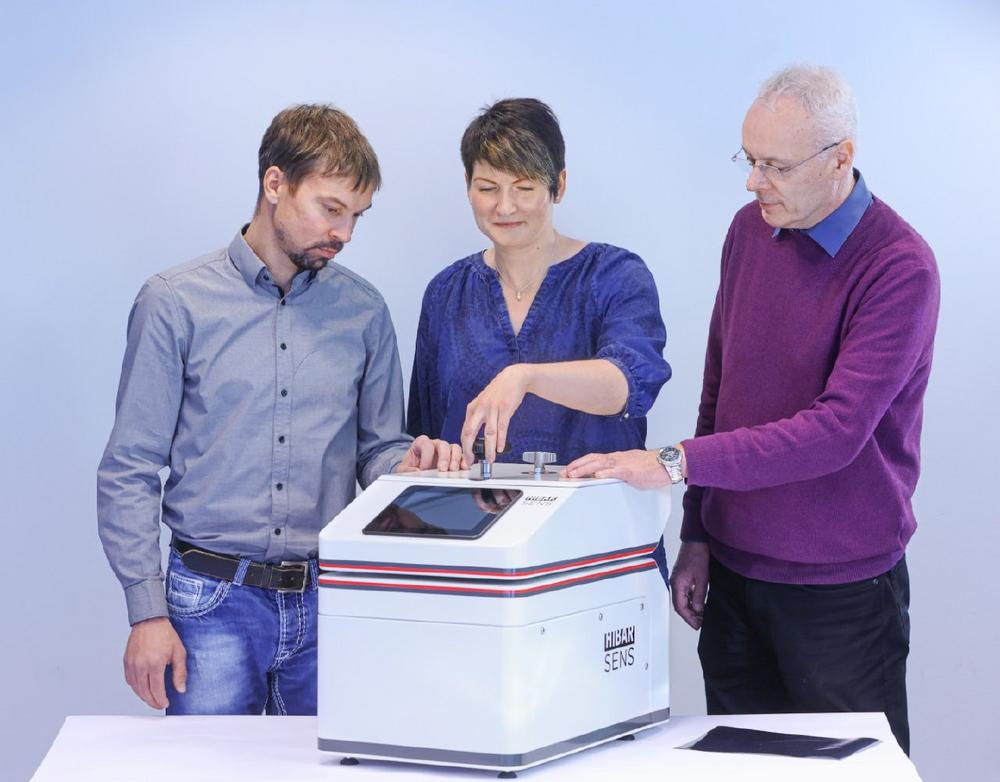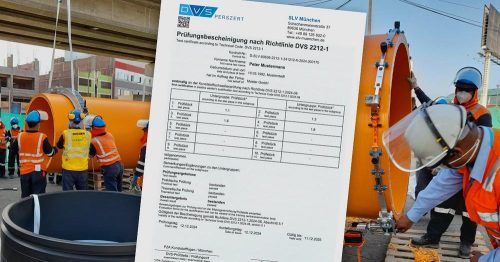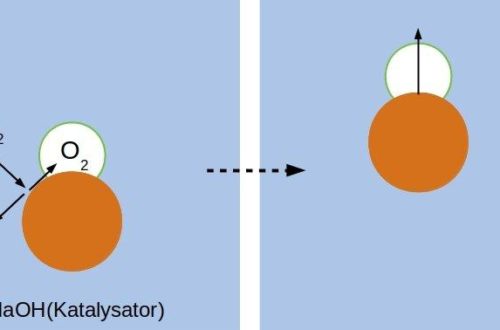
A New Generation of Instruments for Gas Permeation Measurement
To enable the simultaneous measurement of water vapor permeation rate (WVTR) and oxygen permeation rate (OTR) in a single device, researchers at Fraunhofer IWS are combining laser diode spectroscopy for water vapor measurement with dynamic fluorescence quenching for oxygen measurement in a single measuring cell. A simple but effective trick came into play to achieve a sufficiently low detection limit for the concentration measurement of both permeates also for ultra-barrier film: nitrogen pulses precisely control the concentrations of water vapor and oxygen molecules penetrating the barrier layer. This now discontinuous nitrogen flow can be controlled very precisely by automated opening and closing of valves. As a result, even small amounts of permeate accumulate to levels that can be reliably measured by laser spectroscopy or fluorescence quenching detectors, provided that all equilibrium conditions are maintained. The phase durations of the nitrogen pulses and the intervening permeate accumulation are adjustable to almost any desired value. The detection limits of both WVTR and OTR measurements no longer depend on the sensor used, but on the sealing of the measuring cell.
Particularly Interesting for the Electronics, Pharmaceutical and Food Industries
In the meantime, the Dresden institute has filed a patent for the new technology. “We expect this method to raise permeation measurement technology to a new level,” estimates Dr. Wulf Grählert, who led the SimPerm project at Fraunhofer IWS. ”The advantages are obvious: We can use it to examine the gas permeability of any barrier films for OLEDs, pharmaceutical products or medical technology applications, but also for food, much more realistically and thus more reliably, without having to make any compromises in terms of sample size or examination temperature.” For the first time, laboratories can perform such permeation measurements for typical air components such as water vapor and oxygen in a single operation and with a single instrument, reducing the capital and operating costs of typical gas permeation testing. It also provides information on the breakthrough behavior of the permeates, showing how quickly, or more accurately, how slowly a given amount of water vapor or oxygen permeates through the barrier. Last but not least, the reliable simultaneous analysis of the permeation properties allows conclusions to be drawn about how the different permeates influence each other during the passage through the barrier layers.
Looking further into the future, even more fields of application could open up for the innovative measurement technology: “Cardiac pacemakers and other implants have to be particularly protected against moisture in the body at certain points,” explains Grählert. Because the new technology enables reliable, highly sensitive comprehensive permeation analysis even on very small sample areas, this greatly facilitates the development of new barrier films.
As a next step, Dresden-based Sempa Systems GmbH plans to build market-ready measuring systems based on this technology. In addition to Fraunhofer IWS and Sempa Systems GmbH, the Dresden-based CREAVAC GmbH was a partner in the joint project SimPerm, which has now been completed. The Saxon State Ministry for Economics, Labor and Transportation had funded the project from 2018 to 2022 with 1.3 million euros from EFRE funds.
For more information: https://www.iws.fraunhofer.de/de/sab-projekte.html#SimPerm
About Sempa Systems GmbH
SEMPA SYSTEMS GmbH was founded in 2001 and has established itself as a reputable supplier of highest-purity gas and chemical supply systems, also for very special applications. Customers include major companies in the semiconductor and LED industries as well as representatives of the photovoltaic and pharma sectors. The company employs 130 people at its sites in Dresden (headquarters) and Hermsdorf (Thuringia).
As of November 1, 2021 SEMPA is owned by the global Meptagon Group, a multidisciplinary engineering and construction company with a presence in Ireland, Central Europe, Israel and India. The merger of Meptagon and SEMPA creates synergies. The combination of high-end process equipment, state-of-the-art design and integration capabilities, and multidisciplinary construction services in various industries offers new development potential and thus the opportunity for greater product diversification.
Infobox
Permeation Measuring
How permeable is a film for water vapor or oxygen? To answer this question, Fraunhofer IWS has developed a measuring system based on the classical concept of barrier measurement. The film to be measured divides a sample chamber into two halves. Water vapor and oxygen with known concentrations are introduced into one half. In the other half of the chamber, the water vapor or oxygen molecules that have actually penetrated the barrier film are measured. Instead of a continuous flow of nitrogen, a precise pulsed flow allows both the accumulation and reaching the equilibrium state of the two gases that have permeated, so that even the smallest amounts of permeate reliably can be detected.
To determine the concentration of the permeated water vapor molecules, an infrared laser beam in a specific frequency range is used as a sensor. A photodetector determines how much the water vapor molecules attenuate the light. This allows to calculate the rate at which the water vapor penetrates the barrier film. The method allows reliable determination of the water vapor permeation rate between 10 and 10-6 g m-2 d-1.
To determine the concentration of oxygen molecules, a pad with a special coating is irradiated with green LED light, causing it to emit fluorescent light. Any oxygen molecule in the immediate vicinity will partially quench the fluorescent light. This quenching can be measured with a photodetector to determine the oxygen concentration in the nitrogen flow and the oxygen permeation rate. This can be reliably measured between 10+3 and 10‑3 cm3 m‑2 d‑1 bar‑1
Fraunhofer-Institut für Werkstoff- und Strahltechnik IWS
Winterbergstraße 28
01277 Dresden
Telefon: +49 (351) 83391-0
Telefax: +49 (351) 83391-3300
http://www.iws.fraunhofer.de
Optical Inspection Technology
Telefon: +49 (351) 83391-3234
E-Mail: Beate.Leupolt@iws.fraunhofer.de
Leiter Unternehmenskommunikation
Telefon: +49 (351) 83391-3614
Fax: +49 (351) 83391-3300
E-Mail: markus.forytta@iws.fraunhofer.de
![]()




